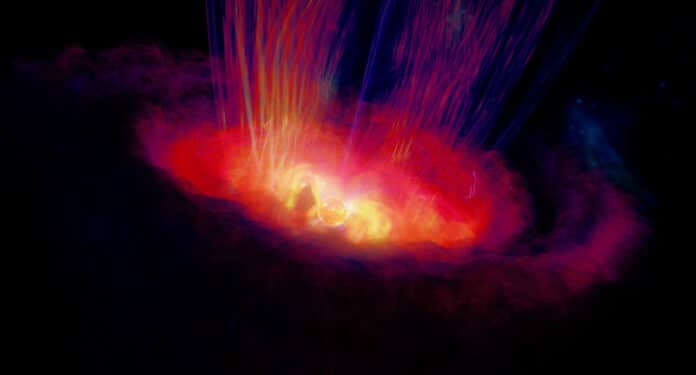The Fermi Gamma-ray Space Telescope, with the Large Area Telescope (LAT) onboard, has been studying the Universe since 2008. From these observations, about 30% of gamma-ray sources detected throughout the night sky remain unidentified – the origins of these gamma-ray detections are unknown.
PhD candidate Agostina Filócomo and scholars investigated several of these enigmatic sources to ascertain their origin. This new study focuses on the star-forming region NGC 2071, which lies in the northern part of the molecular cloud Orion B.
A team of researchers from Spain and Argentina has revealed the first observable proof that the youthful, low-mass T Tauri stars can generate gamma radiation. T Tauri stars have a core star and an orbiting ring of gas and dust where planets might form. T Tauri stars are renowned for their fluctuating brightness and are frequently discovered close to areas where star formation occurs.
The scientists noticed that the young star-forming region NGC 2071 is in the same sky area as three unidentified gamma emitters seen at various times. In this region, at least 58 T Tauri stars are known to be forming. There aren’t other objects in this area that could produce gamma rays.
The infrequent production of gamma-ray radiation by T Tauri stars during intense flare episodes known as “megaflares,” in which electromagnetic bursts are created by magnetic energy stored in the stars’ atmospheres, is one theory that has been put forth. Megaflares can last for a few hours and cover a few star radii. The Sun is currently experiencing flare activity, but it is not on the same level as a megaflare. Megaflares are much more potent and would be harmful to life on Earth if they occurred on the Sun.
This may provide light on several previously unidentified gamma-ray sources. Understanding T Tauri stars’ physical processes also helps us better understand the pre-Sun and pre-Solar System settings.
Ph.D. student Agostina Filócomo claims, “This observational evidence is essential for understanding the origin of sources that have previously remained unknown for more than a decade, which is unquestionably a step forward in astronomy.”
“It is also critical to comprehend the processes that occur during the early phases of star formation: if a T Tauri star produces gamma-ray radiation, it will affect the gas conditions of the protoplanetary disk and, consequently, the evolution of planet formation. The discovery of this phenomenon serves to understand how the Sun and our home planet, Earth, were formed and evolved.”
Journal Reference:
A Filócomo, J F Albacete-Colombo, E Mestre, L J Pellizza and J A Combi. γ-ray detection from occasional flares in T Tauri stars of NGC 2071 – I. Observational connection. Monthly Notices of the Royal Astronomical Society. DOI: 10.1093/mnras/stad2029
